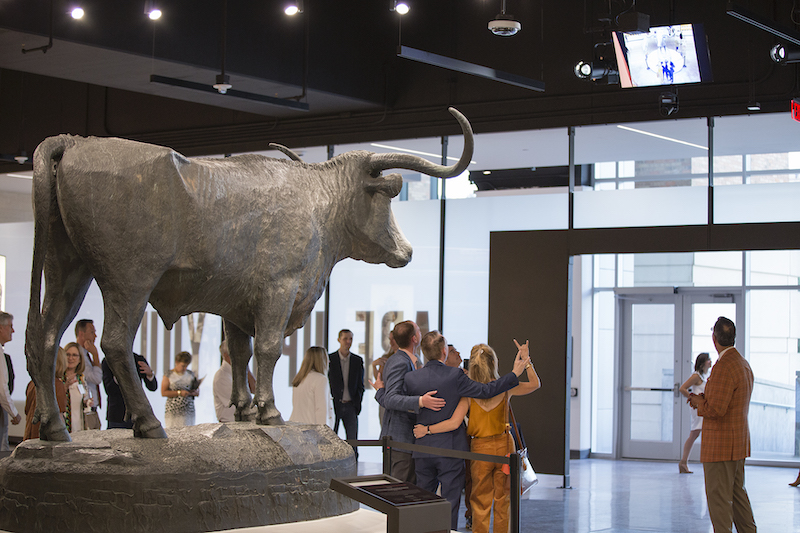Last Friday, the University of Texas at Austin held a grand opening ceremony for the Frank Denius Family Athletics Hall of Fame, a 24,713-sf space that is located at the north endzone of Darrell K. Royal-Texas Memorial Stadium.
The $17.1 million space, designed by Page and built by Turner Construction, includes 392 trophies earned over the decades by the university’s 20 sports teams. Visual and digital displays celebrate UT’s 55 national championship teams, 599 conference team titles, 144 individual national champions, and 171 Olympians who have won 145 medals.
The national champions are highlighted in their own 1,400-sf room with a 16x9-ft monitor that plays videos commemorating team title victories.
Also included in the Hall of Fame is an 8-ft-tall, 1,200-lb statue honoring the school’s mascot, the longhorn Bevo. The Hall of Fame offers a visual timeline of the 15 Bevos in Texas’ history since 1917.
Nashville, Tenn.-based Advent was a co-collaborator on this project, responsible for creating the “stories” that identify special touchstones and moments in the history of UT’s athletic programs.
John Roberson, Advent’s owner, had worked previously with Chris Del Conte, UT’s Athletic Director, when Del Conte held the same post at Texas Christian University. “Chris was brought in as a change agent, to restore the culture” for UT’s athletic program, Roberson tells BD+C.
That culture, he explains, is defined by stories “that are repeated.” Telling those stories required Advent to pull together the school’s trophies and other memorabilia that were scattered all over the place. For example, a Wheaties box that featured UT’s 2005 national championship football team and its legendary coach Mack Brown was found in someone’s garage. Trophies won by the school’s baseball team were located in crates in the basement of the team’s fieldhouse.
It’s not just the trophies that matter, though, says Roberson. “It’s identifying the heroes” and the narratives about individuals, teams, and special moments. Advent helped UT select those people and events using a proprietary process called “story mining,” which Roberson describes as “empathetic listening” to stakeholders. Advent used data analysis software to identify within those captured stories what needed to be told “to uncover the emotions” of the time and place.
“We’re transporting you, taking you back,” says Roberson, via images and interactive exhibits. “Memory is created by the experience that causes wonderment.”

A statue of UT's mascot, the longhorn Bevo, is prominently displayed in the Hall of Fame. Image: Rick Myers/Advent
Darrell K. Royal-Texas Memorial is the ninth-largest stadium in the world, with a seating capacity of 100,119. So, says Roberson, several hundred thousand people could conceivably visit the Hall of Fame during the football team’s season, which opened with a 45-14 win over Louisiana Tech University last Saturday. Roberson expects UT to also use this facility as part of its student recruitment effort, and to lease it out for events like weddings.
He believes the Hall of Fame is a “smart investment” for the university to recapture a space that had been a wide concourse and circulation area with a modest food court.
In conjunction with the opening of the Hall of Fame, UT has entered into a joint branding agreement with the U.S. Olympic and Paralympic Committee in an effort to strengthen Olympic sports programming at the collegiate level. The tagline for the campaign is “Olympians Made Here.”
The Athletics Hall of Fame is named after Frank Denius, an alumnus who passed away in 2018 at the age of 93. Denius was a decorated World War II veteran, having been awarded four Silver Stars and two Purple Hearts. He earned two degrees, in business and law, at UT, and supported the university philanthropically.
Related Stories
| Jul 18, 2014
Top Architecture Firms [2014 Giants 300 Report]
Gensler, Perkins+Will, NBBJ top Building Design+Construction's 2014 ranking of the largest architecture firms in the United States.
| Jul 18, 2014
2014 Giants 300 Report
Building Design+Construction magazine's annual ranking the nation's largest architecture, engineering, and construction firms in the U.S.
| Jul 17, 2014
A new, vibrant waterfront for the capital
Plans to improve Washington D.C.'s Potomac River waterfront by Maine Ave. have been discussed for years. Finally, The Wharf has started its first phase of construction.
| Jul 8, 2014
Does Zaha Hadid’s Tokyo Olympic Stadium have a design flaw?
After being criticized for the cost and size of her stadium design for the 2020 Olympics in Tokyo, a Japanese architect points out a major design flaw in the stadium that may endanger the spectators.
| Jul 8, 2014
Frank Lloyd Wright's posthumous gas station opens in Buffalo
Eighty-seven years after Frank Lloyd Wright designed an ornamental gas station for the city of Buffalo, the structure has been built and opened to the public—inside an auto museum.
| Jul 7, 2014
7 emerging design trends in brick buildings
From wild architectural shapes to unique color blends and pattern arrangements, these projects demonstrate the design possibilities of brick.
| Jul 7, 2014
A climate-controlled city is Dubai's newest colossal project
To add to Dubai's already impressive portfolio of world's tallest tower and world's largest natural flower garden, Dubai Holding has plans to build the world's largest climate-controlled city.
| Jul 3, 2014
Arthur Ashe Stadium the latest to tap Birdair
The United States Tennis Association (USTA) and ROSSETTI, the architect of record for the Arthur Ashe Stadium, tapped Birdair to supply a 210,000-square-foot, PTFE membrane, retractable roof, expected to be installed by 2016.
| Jul 2, 2014
First Look: Qatar World Cup stadium design references nomadic heritage
Organizers of the Qatar 2022 World Cup, the Supreme Committee for Delivery and Legacy, recently unveiled designs for the second stadium.
| Jul 2, 2014
Emerging trends in commercial flooring
Rectangular tiles, digital graphic applications, the resurgence of terrazzo, and product transparency headline today’s commercial flooring trends.

















